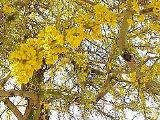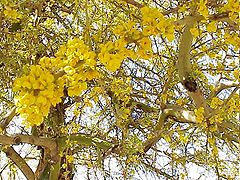
Geoffroea decorticans
Encyclopedia

South America
South America is a continent situated in the Western Hemisphere, mostly in the Southern Hemisphere, with a relatively small portion in the Northern Hemisphere. The continent is also considered a subcontinent of the Americas. It is bordered on the west by the Pacific Ocean and on the north and east...
. The chañar is cold and drought deciduous; it loses its leaves in winter, and possibly in summer if conditions get too dry. It is natural to Chile and Argentina, also present in Paraguay and southern Peru. It is a very characteristic tree in local culture and folk because of its vivid visual presence, propagation, and ancient ethnomedical uses.
Morphology
The common name Chilean Palo Verde comes from the mottled green color of the trunks but does not seriously resemble Cercidium. The chañar tends to be quite upright with a spreading canopy with both straight and mildly curving trunks. As trees mature the trunks and branches take on a sculptural quality with long longitudinal, irregular ridges and valleys. Along with this undulating trunk, large flakes of the bark peel off or decorticate (hence the species name decorticans). The peeling tan to brown bark is eventually shed revealing the dark green, "immature" trunk beneath. The contrasting colors and textures created by this puzzle-piece pattern make the tree visually fascinating.The flowers are very visible, small, papery and yellow coloured.The tree flowers in spring, either singly or in clusters. Geoffroea decorticans is unique among legumes in that it produces fleshy, oval pods that hold a single seed. Fruit are initially green but turn deep orange as they mature.
Distribution and habitat
This tree inhabits dry to arid spiniferous forests in a rather broad area of southern South America which extends mainly through I to IV regions of ChileChile
Chile ,officially the Republic of Chile , is a country in South America occupying a long, narrow coastal strip between the Andes mountains to the east and the Pacific Ocean to the west. It borders Peru to the north, Bolivia to the northeast, Argentina to the east, and the Drake Passage in the far...
and central and northern Argentina
Argentina
Argentina , officially the Argentine Republic , is the second largest country in South America by land area, after Brazil. It is constituted as a federation of 23 provinces and an autonomous city, Buenos Aires...
. Its companions conforming the forest are usually algarrobos
Prosopis
Prosopis is a genus of flowering plants in the pea family, Fabaceae. It contains around 45 species of spiny trees and shrubs found in subtropical and tropical regions of the Americas, Africa, Western Asia, and South Asia. They often thrive in arid soil and are resistant to drought, on occasion...
, quebrachos
Schinopsis
Schinopsis is a genus of South American trees in the family Anacardiaceae. The species within this genus inhabit different regions of the Gran Chaco ecoregion including parts of northern Argentina, Bolivia, and Paraguay....
and the closely related
Fabaceae
The Fabaceae or Leguminosae, commonly known as the legume, pea, or bean family, is a large and economically important family of flowering plants. The group is the third largest land plant family, behind only the Orchidaceae and Asteraceae, with 730 genera and over 19,400 species...
and very abundant cavens
Acacia caven
Acacia caven is an ornamental tree in the Fabaceae family. Acacia caven is native to Argentina, Bolivia, Chile, Paraguay, and Uruguay...
.
Usage
Seeds and fruit since edible are valued as human and animal feed and the yellow wood is suitable for carpentry and furniture making once dry. It is also used as fuel and to make cheap posts for fences.Fruits are very commonly used for both culinary and medical purposes in the processed form of chañar arrope
Molasses
Molasses is a viscous by-product of the processing of sugar cane, grapes or sugar beets into sugar. The word molasses comes from the Portuguese word melaço, which ultimately comes from mel, the Latin word for "honey". The quality of molasses depends on the maturity of the sugar cane or sugar beet,...
. Extremely sweet, dark and thick is very similar to honey
Honey
Honey is a sweet food made by bees using nectar from flowers. The variety produced by honey bees is the one most commonly referred to and is the type of honey collected by beekeepers and consumed by humans...
or vegetable molasses
Molasses
Molasses is a viscous by-product of the processing of sugar cane, grapes or sugar beets into sugar. The word molasses comes from the Portuguese word melaço, which ultimately comes from mel, the Latin word for "honey". The quality of molasses depends on the maturity of the sugar cane or sugar beet,...
and is used as their substitute. It is locally well known to alleviate sore throats and coughing.

